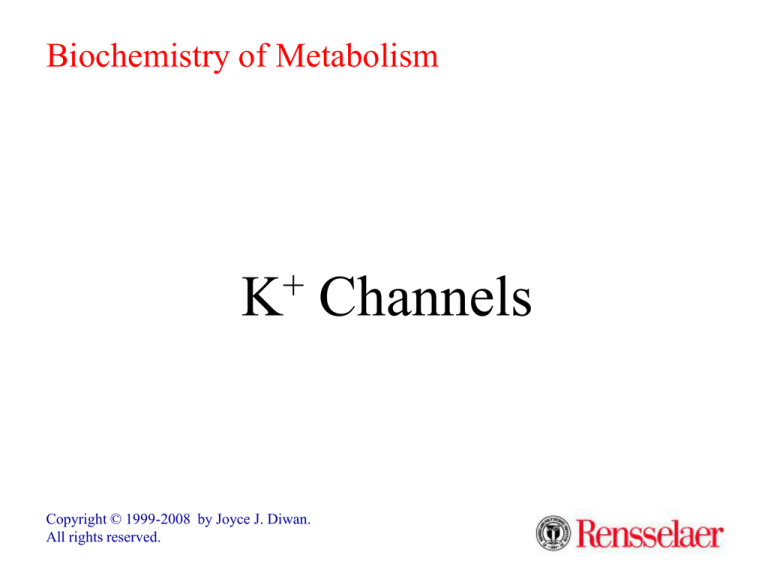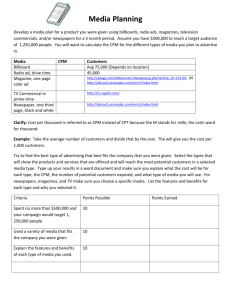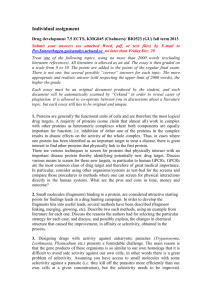
Biochemistry of Metabolism
+
K
Copyright © 1999-2008 by Joyce J. Diwan.
All rights reserved.
Channels
Voltage-gated K+ channels mediate outward K+ currents
during nerve action potentials.
Important advances in understanding have come from:
physiological studies, including the use of patch
clamping
mutational studies of the Drosophila voltage-gated
K+ channel protein, product of the Shaker gene
crystallographic analysis of the structure of
bacterial K+ channels.
molecular dynamics modeling of permeation
dynamics.
4 identical copies of the K+ channel protein,
arranged as a ring, form the channel walls.
extracellular space
H5
Hydropathy analysis &
topology studies predicted the
presence of 6 transmembrane
a-helices in the voltage-gated
K+ channel protein.
+
1
2
3
4
5
6
+
N
cytosol
The core of the channel consists of helices
5 & 6 & the intervening H5 segment of
each of the 4 copies of the protein.
C
extracellular space
H5
+
1
2
3
4
5
6
+
N
cytosol
C
Helices 1-4 function as a voltage-sensing domain,
with helix #4 having a special role in voltage sensing.
This domain is absent in K+ channels that are not
voltage-sensitive.
extracellular space
H5
+
Selectivity:
K+ channels are highly
selective for K+, e.g.,
relative to Na+.
1
2
3
4
5
6
+
N
cytosol
C
The selectivity filter that determines which cation can
pass through a channel is located at the narrowest part.
Mutation studies showed that the H5 segment is essential
for K+ selectivity.
H5 includes a consensus sequence (Thr-Val-Gly-Tyr-Gly)
found in all K+ channels, with only minor changes through
evolution.
extracellular space
H5
The first K+ channel for
which an X-ray crystal
structure was solved is the
KcsA K+ channel from
Streptomyces lividans.
+
1
2
3
4
5
6
+
N
cytosol
C
In this channel protein:
There are only 2 transmembrane a-helices,
corresponding to helices # 5 & 6 in the voltage-gated
channel.
An intervening segment includes the K+ channel
consensus sequence.
Left:
side view,
normal to
membrane.
Right:
view from
the extracellular
space.
KcsA K+ channel: two views
PDB 1J95
The K+ channel consensus sequence (in black) forms
the selectivity filter at the narrowest part of the channel.
K+ ions are bound within the selectivity filter (color pink).
The gate is where the innermost a-helices of the 4
subunits meet at the narrow end of the "teepee" structure.
This is the closed channel.
As K+ enters the channel, its
waters of hydration are
replaced by oxygen atoms
lining the selectivity filter.
4 K+ binding sites within the
selectivity filter are defined by
5 rings of oxygen atoms.
Each ring includes 4 oxygen
atoms, 1 from each subunit.
KcsA K+ channel: side view
Most are backbone oxygens of the consensus sequence.
Each bound K+ interacts with 8 oxygen atoms, as it sits
between 2 of the rings of oxygen atoms.
See webpage of R. MacKinnon for additional diagrams.
A K+ ion is seen
closely interacting
with the outermost
ring of oxygen atoms.
K+ channel in spacefill display
with CPK color, end view
The arrangement of O atoms surrounding each K+ within
the selectivity filter mimics that of a hydrated K+ ion.
Thus the energy barrier for entry & exit of K+ is low.
Solved X-ray structures such
as at right, which average over
many copies of the channel,
show K+ in all 4 binding sites.
KcsA K+ channel: side view
Based on predicted electrostatic repulsion & other
evidence, K+ is assumed to occupy actually every other
binding site, with a water in each intervening site.
K+ & H2O alternately pass single file through the channel.
As a K+ ion binds at one end of the selectivity filter, a K+
ion exits at the other end.
Na+, being smaller than K+, would be able to interact
with oxygen atoms on only one side of the channel.
Thus removal of the waters of hydration from Na+,
for entry into the channel, would be less favored
energetically.
Furthermore, K+ within the selectivity filter is
required to stabilize its ion-conducting conformation.
If Na+ is substituted for K+ in the medium, the
selectivity filter undergoes a conformational change
to a partly collapsed state.
Channel
Gating:
MthK channel, open state: side & end views PDB 1LNQ
The structure of a Ca++-dependent K+ channel from
Methanobacterium thermoautrophicum, MthK, was the
first to be solved in the open state, providing
information about the mechanism of channel gating.
The selectivity filter (K+ channel consensus sequence)
is colored black in the diagram above.
Channel opening is associated
with a bend at a glycine residue in
the innermost helix of each copy
of the MthK channel protein.
In the mammalian voltage-gated
K+ channel, a Pro-Val-Pro (PXP)
motif in the same helix functions
as the gating hinge.
In contrast to the teepee shape
of the closed KcsA channel, the
outward splaying of bent helices
provides a large opening at the
cytosolic end of the open MthK
channel.
MthK channel: side view
KcsA K+ channel: side view
channel
Ca++
MthK channel with gating ring: side & end views
PDB 1LNQ
MthK includes a large extracellular protein assembly
involved in regulation of gating by Ca++.
The Ca++-binding gating ring does not itself block ion flow.
It induces channel conformational changes of gating.
Voltage sensing:
Mutational analysis showed
(+) residues in helix #4 to be
essential for voltage gating.
extracellular space
H5
+
1
2
3
In helix #4 every 3rd residue
N
is Arg or Lys, & intervening
residues are hydrophobic.
cytosol
Decreased transmembrane
potential causes helix #4 to change
H3N+
position, resulting in more of its (+)
charges being accessible to the
aqueous phase outside the cell.
A small "gating current" is
measurable, as (+) charges effectively
move outward.
4
5
6
+
C
H
H
C
COO H3N+ C
COO
CH2
CH2
CH2
CH2
CH2
CH2
NH
CH2
+
C
NH2
+ NH
3
NH2
arginine
lysine
Crystal structures have been determined for:
a bacterial voltage-gated K+ channel KvAP
a mammalian equivalent of the Shaker channel
designated Kv1.2.
The core of both voltage-gated channels (selectivity filter
& two transmembrane a-helices of each of four copies of
the protein) is similar to that of other K+ channels.
On the next slide is shown the bacterial KvAP channel, in
the open conformation.
voltage-sensor ‘paddle’
K+ in selectivity filter
side view within membrane
facing membrane
Voltage-gated K+ Channel
PDB 1ORQ
Some a-helices of the voltage-sensing domain of the
differ from the expected trans-membrane orientation.
The (+) charged voltage-sensing helix #4, & part of what
was designated helix #3, associate in a helix-turn-helix to
form a "paddle" shape at the periphery of the channel.
Fab fragments of monoclonal antibodies raised to the
voltage-sensor domain of the KvAP channel protein were
used to promote crystallization of the KvAP channel.
The structure of the mammalian equivalent of the Shaker
channel has been determined in the absence of FAB
fragments but in complex with a regulatory protein.
In this channel, a-helices of the voltage-sensing domain
are tilted relative to the plane of the membrane but have a
more transmembrane orientation.
For diagrams see: website (Brookhaven Nat. Lab)
article (Long et al., Science).
Some differences between solved KvAP & Shaker
channel structures are postulated to be due to altered
conformation of the KvAP channel on being removed
from the lipid membrane.
A genetically engineered chimaeric channel, in which
the voltage sensor paddle of another K+ channel is
incorporated into the Shaker-type Kv1.2 channel, has
been crystallized in the presence of lipids.
The structure of this channel in a lipid membrane-like
environment is found to be similar to that of the
previously solved Kv1.2 structure.
According to current models, a voltage change drives
movement of each positively charged voltage sensor
paddle complex across the membrane.
This exerts tension, via a linker segment, on the end of
each inner helix of the channel core to promote bending,
and thus channel opening.
Recent high-resolution structural studies permit predictions
of how acidic residues may stabilize positive charges on
the paddle as it moves within the membrane.
• Diagram (Fig. 6 & others in Nature article)
• Diagram (simplified - see article in webpage)
• Animation - S1 movie (based on X-ray structure, assays of
conformational changes & molecular dynamics simulations)
Closed1
Inactivation:
Closed2
Open
Inactivated
Many channels have multiple open &/or closed states.
There may be an inactivated state, as in the
hypothetical example above.
Voltage-gated K+ channels undergo transient
inactivation after opening.
In the inactivated state, the channel cannot open even if
the voltage is favorable.
This results in a time delay before the channel can
reopen.
extracellular space
H5
+
1
2
3
4
5
6
+
N
cytosol
C
The N-terminus of the Shaker channel (or part of a
separate subunit in some voltage-activated channels) is
essential for inactivation.
Mutants that lack this domain do not inactivate.
Adding back a peptide equivalent to this domain restores
the ability to inactivate.
A "ball & chain" mechanism of
inactivation has been postulated,
in which the N-terminus of one
of the 4 copies of the channel
protein enters the channel from
the cytosolic side of the
membrane to inhibit ion flow.
Open
Inactivated
See a more detailed diagram (Fig. 3).
In some voltage-gated K+ channels, entrance of the
N-terminus into the channel is followed by a
conformational change in the selectivity filter that
contributes to the process of inactivation.









